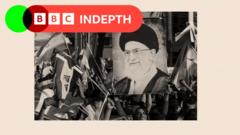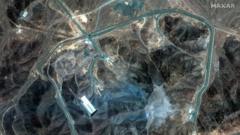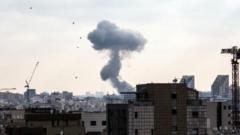In an unprecedented military operation termed 'Operation Midnight Hammer,' the U.S. executed a series of coordinated airstrikes targeting Iran's nuclear facilities. Utilizing advanced tactics, including decoy flights and bunker-buster bombs, U.S. officials claim significant damage was inflicted upon Iran's nuclear capabilities. However, the long-term consequences of these strikes remain uncertain.
U.S. Conducts Precision Strikes on Iranian Nuclear Facilities: An Inside Look at Operation Midnight Hammer

U.S. Conducts Precision Strikes on Iranian Nuclear Facilities: An Inside Look at Operation Midnight Hammer
Detailed analysis of the U.S. military's recent airstrikes on Iran's nuclear capabilities, showcasing the complexities and implications of Operation Midnight Hammer.
Empty line
The United States has unveiled the intricacies of its recent military operation, dubbed ‘Operation Midnight Hammer,' which targeted Iran's nuclear facilities through a meticulously planned series of strikes. During a Pentagon briefing, four-star General Dan Caine provided insights into the complex mission that involved an 18-hour flight, multiple mid-air refuelings, and the deployment of decoy aircraft to mislead potential adversaries.
According to U.S. Secretary of Defense Pete Hegseth, the operation began shortly after midnight, when President Donald Trump and senior officials gathered in the White House Situation Room to oversee the departure of a fleet of B-2 stealth bombers from Whiteman Air Force Base in Missouri. Loaded with "bunker buster" munitions capable of penetrating deep concrete structures, these bombers’ target was Iran's fortified nuclear enrichment facility at Fordo, buried beneath a mountain.
As the details of the mission unfolded, it became clear that the U.S. had employed a ruse: while bombers appeared to be dispatched to Guam, a small group of planners and leaders orchestrated the actual strikes heading towards Iran. The stealth bombers navigated with minimal communication, safely reaching their target zone in the Middle East by late afternoon EDT, supported by additional aircraft for aerial protection.
After assessing potential threats, the bombers commenced strikes without encountering any opposition from Iranian defenses, a situation attributed to Israeli air dominance in the region. Despite the apparent success of the mission, questions linger regarding the actual damage inflicted on Iran’s nuclear capabilities. U.S. officials celebrated the operation as a major victory, stating that Iran's nuclear regime had been "obliterated," though Iran downplayed the extent of the damage.
As part of the coordinated attack, the U.S. also launched over two dozen Tomahawk cruise missiles from a submarine in the Arabian Sea towards another key site near Isfahan, aligning the strikes from various platforms to maximize surprise and effectiveness. The operation culminated in the release of fourteen Massive Ordnance Penetrators (MOPs) in short succession, targeting heavily fortified locations at Fordo and Natanz.
The Pentagon boldly emphasized that this operation highlighted a level of military sophistication unparalleled globally, yet experts remain cautious about the potential long-term ramifications for Iran's nuclear agenda. With the full impact still to be assessed, future developments in U.S.-Iran relations and regional stability may hinge on this significant escalation of military action.
The United States has unveiled the intricacies of its recent military operation, dubbed ‘Operation Midnight Hammer,' which targeted Iran's nuclear facilities through a meticulously planned series of strikes. During a Pentagon briefing, four-star General Dan Caine provided insights into the complex mission that involved an 18-hour flight, multiple mid-air refuelings, and the deployment of decoy aircraft to mislead potential adversaries.
According to U.S. Secretary of Defense Pete Hegseth, the operation began shortly after midnight, when President Donald Trump and senior officials gathered in the White House Situation Room to oversee the departure of a fleet of B-2 stealth bombers from Whiteman Air Force Base in Missouri. Loaded with "bunker buster" munitions capable of penetrating deep concrete structures, these bombers’ target was Iran's fortified nuclear enrichment facility at Fordo, buried beneath a mountain.
As the details of the mission unfolded, it became clear that the U.S. had employed a ruse: while bombers appeared to be dispatched to Guam, a small group of planners and leaders orchestrated the actual strikes heading towards Iran. The stealth bombers navigated with minimal communication, safely reaching their target zone in the Middle East by late afternoon EDT, supported by additional aircraft for aerial protection.
After assessing potential threats, the bombers commenced strikes without encountering any opposition from Iranian defenses, a situation attributed to Israeli air dominance in the region. Despite the apparent success of the mission, questions linger regarding the actual damage inflicted on Iran’s nuclear capabilities. U.S. officials celebrated the operation as a major victory, stating that Iran's nuclear regime had been "obliterated," though Iran downplayed the extent of the damage.
As part of the coordinated attack, the U.S. also launched over two dozen Tomahawk cruise missiles from a submarine in the Arabian Sea towards another key site near Isfahan, aligning the strikes from various platforms to maximize surprise and effectiveness. The operation culminated in the release of fourteen Massive Ordnance Penetrators (MOPs) in short succession, targeting heavily fortified locations at Fordo and Natanz.
The Pentagon boldly emphasized that this operation highlighted a level of military sophistication unparalleled globally, yet experts remain cautious about the potential long-term ramifications for Iran's nuclear agenda. With the full impact still to be assessed, future developments in U.S.-Iran relations and regional stability may hinge on this significant escalation of military action.






















